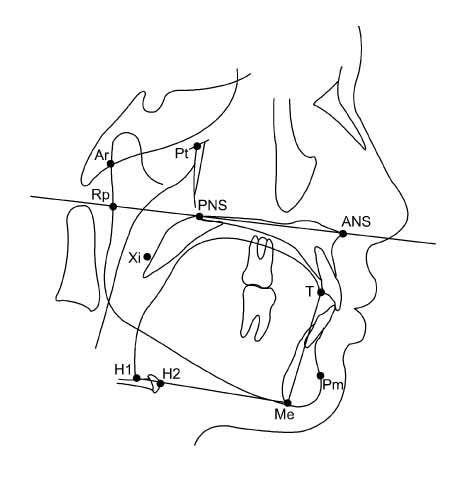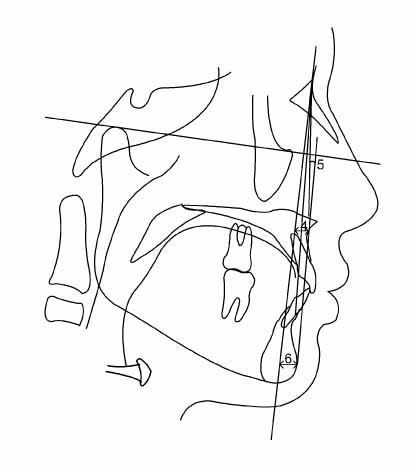Effect of airway and tongue in facial morphology of prepubertal Class I, II children
- Affiliations
-
- 1Department of Orthodontics, Kangdong Sacred Heart Hospital, Hallym University Medical Center, Korea. dentpark64@hanmail.net
- 2Department of Orthodontics, School of Dentistry, Yonsei University, Korea.
- 3Department of Orthodontics, School of Dentistry, Wonkwang University, Korea.
- 4Department of Orthodontics, Graduate School of Hallym University, Korea.
- KMID: 1481495
- DOI: http://doi.org/10.4041/kjod.2008.38.2.74
Abstract
OBJECTIVE
This study examined the craniofacial morphology of young patients in their prepubertal stage showing class I, II malocclusion, by analyzing lateral cephalograms, and analyzed its relationship with tongue position, tongue space, and airway space in order to ascertain the effects of nasopharyngeal airway and tongue morphology on the form of the malocclusion.
METHODS
Seventy-six patients aging from 9 to 11 were divided into two groups depending on the ANB difference on the lateral cephalogram: Experimental group (Cl II malocclusion group) showing 0 ANB difference < or = < 4.0; Control group (Cl I malocclusion group) showing 0 < ANB difference < 4.0. The tongue space, space between palate and tongue, nasopharyngeal airway space and craniofacial morphology were compared between the two groups.
RESULTS
Tongue space, palate-tongue space, nasopharyngeal airway space showed no significant differences between class I and class II malocclusion groups. Hyperdivergent faces were associated with smaller nasopharyngeal airway space. Longer anterior facial height and posterior facial height were associated with larger tongue space, and greater anterior facial height were associated with lower tongue position. Smaller nasopharyngeal airway space showed smaller tongue space.
CONCLUSIONS
Tongue space and nasopharyngeal airway space showed no significant differences between class I malocclusion group and class II malocclusion group. Only anterior facial height and posterior facial height had an influence on tongue space and nasopharyngeal airway space.
Figure
Cited by 3 articles
-
Pharyngeal airway analysis of different craniofacial morphology using cone-beam computed tomography (CBCT)
Yong-Il Kim, Seong-Sik Kim, Woo-Sung Son, Soo-Byung Park
Korean J Orthod. 2009;39(3):136-145. doi: 10.4041/kjod.2009.39.3.136.The relationship between upper airway width and facial growth changes in orthodontic treatment of growing children
Yoon-Ji Kim, Gyoo-Suk Bok, Kyu-Hong Lee, Yong-In Hwang, Yang-Ho Park
Korean J Orthod. 2009;39(3):168-176. doi: 10.4041/kjod.2009.39.3.168.Three dimensional analysis of the upper airway and facial morphology in children with Class II malocclusion using cone-beam computed tomography
Ji-Suk Hong, Dae-Sung Kim, Kyung-Min Oh, Yoon-Ji Kim, Kyu-Hong Lee, Yang-Ho Park
Korean J Orthod. 2010;40(3):134-144. doi: 10.4041/kjod.2010.40.3.134.
Reference
-
1. Subtelny JD. Width of the nasopharynx and related anatomic structures in normal and unoperated cleft palate children. Am J Orthod. 1955. 41:889–909.
Article2. Tamari K, Shimizu K, Ichinose M, Nakata S, Tadahama Y. Relationship between tongue volume and lower dental arch sizes. Am J Orthod Dentofacial Orthop. 1991. 100:453–458.
Article3. Moyers RE. Etiology of Malocclusion. Handbook of Orthodontics. 1988. Chicago: Year Book Medical Publishers.4. Solow B, Siersbaek-Nielsen S, Greve E. Airway adequacy, head posture, and craniofacial morphology. Am J Orthod. 1984. 86:214–223.
Article5. Linder-Aronson S. Adenoids. Their effect on mode of breathing and nasal airflow and their relationship to characteristics of the facial skeleton and the denition. A biometric, rhino-manometric and cephalometro-radiographic study on children with and without adenoids. Acta otolaryngol Suppl. 1970. 265:1–132.6. Emslie RD, Massler M, Zwemer JD. Mouth breathing. 1. Etiology and effects; a review. J Am Dent Assoc. 1952. 44:506–521.7. Subtelny JD, Sakuda M. Open-bite, Diagnosis and treatment. Am J Orthod. 1964. 50:337–358.
Article8. Melsen B, Stensgaard K, Pedersen J. Sucking habits and their influence on swallowing pattern and prevalence of malocclusion. Eur J Orthod. 1979. 1:271–280.
Article9. Lessa FC, Enoki C, Feres MF, Valera FC, Lima WT, Matsumoto MA. Breathing mode influence in craniofacial development. Rev Bras Otorrinolaringol. 2005. 71:156–160. (EnglEd).
Article10. Lopatiene K, Babarskas A. Malocclusion and upper airway obstruction. Medicina. 2002. 38:277–283. (Kaunas).11. Houston WJ. The analysis of errors in orthodontic measurements. Am J Orthod. 1983. 83:382–390.
Article12. Proffit WR. Contemporary orthodontics. 2007. 4th ed. St Louis: Mosby;27–29.13. Jaw TS, Sheu RS, Liu GC, Lin WC. Development of adenoids: a study by measurement with MR images. Kaohsiung J Med Sci. 1999. 15:12–18.14. Valera FC, Travitzki LV, Mattar SE, Matsumoto MA, Elias AM, Anselmo-Lima WT. Muscular, functional and orthodontic changes in pre school children with enlarged adenoids and tonsils. Int J Pediatr Otorhinolaryngol. 2003. 67:761–770.
Article15. Niikuni N, Nakajima I, Akasaka M. The relationship between tongue-base position and craniofacial morphology in preschool children. J Clin Pediatr Dent. 2004. 28:131–134.
Article16. Cooper BC. Nasorespiratory function and orofacial development. Otolaryngol Clin North Am. 1989. 22:413–441.
Article17. Mergen DC, Jacobs RM. The size of Nasopharynx associated with normal occlusion and class II malocclusion. Angle Orthod. 1970. 40:342–346.18. Behlfelt K, Linder-Aronson S, McWilliam J, Neander P, Laage-Hellman J. Cranio-facial morphology in children with and without enlarged tonsils. Eur J Orthod. 1990. 12:233–243.
Article19. Linder-Aronson S. Respiratory function in relation to facial morphology and the dentition. Br J Orthod. 1979. 6:59–71.
Article20. Hopkin GB. Neonatal and adult tongue dimensions. Angle Orthod. 1967. 37:132–133.21. Lowe AA, Takada K, Yamagata Y, Sakuda M. Dentoskeletal and tongue soft-tissue correlates : A cephalometric analysis of rest position. Am J Orthod. 1985. 88:333–341.
Article22. Subtelny JD. The significance of adenoid tissue in orthodontia. Angle Orthod. 1954. 24:59–69.23. Yoo E, Murakami S, Takada K, Fuchihata H, Sakuda M. Tongue volume in human female adults with mandibular prognathism. J Dent Res. 1996. 75:1957–1962.
Article24. Eifert DF. A roentogenographic cephalometric study of the tongue. Am J Orthod. 1960. 46:226–227.
- Full Text Links
- Actions
-
Cited
- CITED
-
- Close
- Share
- Similar articles
-
- A study on the correlation between airway space and facial morphology in Class III malocclusion children with nasal obstruction
- A cephalometric study on the airway size according to the types of the malocclusion
- Three dimensional analysis of the upper airway and facial morphology in children with Class II malocclusion using cone-beam computed tomography
- A radiographic study of tongue posture at rest position and during the phonation of /s/ in Class III malocclusion
- A roentgenocephalometric study on the relationship between head posture and craniofacial morphology






